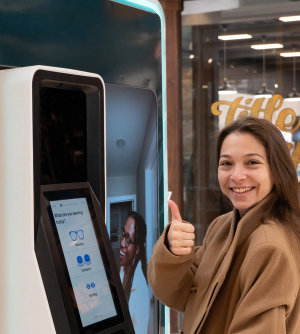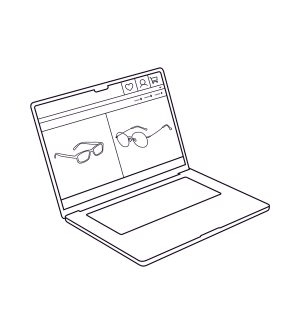ARTICLE
Overcoming Barriers to Vision Care with Eyebot
Vision is one of our most valuable senses and is essential to good health and well-being. Having poor eyesight can disrupt all aspects of life, ranging from everyday activities like walking to more significant tasks such as studying or working.
LEARN MORE
Why is vision care so important?
Vision is one of our most valuable senses and is essential to good health and well-being. Having poor eyesight can disrupt all aspects of life, ranging from everyday activities like walking to more significant tasks such as studying or working. In children, vision impairment can delay development and interfere with performance in school.(1)
For adults, vision loss can increase the risk for chronic diseases and limit the ability to provide for oneself financially.(1-3) In old age, vision impairment can lead to social isolation, higher chances of injury from falls, and overall loss of independence.(1,3)
In 2017 alone, the US economic burden from vision impairment and blindness was $132 billion, with medical and nursing home costs and a decreased workforce being the largest contributors.(4) Regular vision care to check eye health and receive appropriate eyewear is critical for maintaining your best eyesight and quality of life.
Access to care and vision outcomes are not equal
Vision care is not equally accessible to everyone, and many disparities exist, creating a difference in visual outcomes. Socio-economic status, race or ethnicity, and living in a rural area are major predictors of vision care access and outcomes.(5-10) People experiencing poverty, with lower income, lower levels of education, and lacking insurance are less likely to have eye exams or be able to purchase eyeglasses.(6-10)
In rural populations, risk of vision impairment increases due to limited access to eye doctors, with patients needing to travel far distances or wait for long periods of time to be seen.(5-6) Racial and ethnic minorities, burdened by the lasting effects of historical and structural racism, are disproportionately affected by poverty and low socio-economic status.(7)
As a result, these groups are less likely to access vision care and are at increased risk for vision impairment and eye disease.(7) Many other common barriers exist to accessing vision care, which can be amplified by these social factors.
What is preventing people from accessing the vision care they need?
Cost is the most common complaint for people struggling to access vision care.(2,8,11) One study found that 30% of Americans avoid seeing the eye doctor because of cost.(11) Although the number of adults receiving eye care in the US has increased over the last two decades, so has the percentage of those unable to afford eyeglasses.(12) 1 in 10 US adults, between 8-14 million Americans, need eyeglasses but cannot afford them.(13,14) Estimates for vision insurance vary, with one to two-thirds of Americans lacking coverage for eye exams and prescription eyewear.(12,15,16) Even with insurance, many still struggle to cover the costs.(14,15)
Limited time and transportation are also significant barriers to vision care.(2,5,6) Depending on the type of visit and how busy the doctor is, patients can spend 30 minutes to several hours at an eye appointment. Long wait times cause some patients to leave the doctor’s office without being seen and discourage others from scheduling a visit in the first place.(6-8) Imagine needing to take time off from work and having to travel long distances, through traffic, or waiting for public transportation.
Accessing care can also be challenging for patients who need help from family members to get to and from appointments.(2) Especially in rural settings, distance and inaccessibility by public transportation are significant obstacles to reaching the eye doctor’s office.(5,6,8) Other factors preventing patients from being seen include misconceptions about eye care due to lack of knowledge, cultural norms, language barriers, mistrust of doctors, and negative past experiences.(2,5,6,8,17)
How can Eyebot help to overcome barriers to vision care?
With Eyebot, achieving your best vision is easier than ever. We understand how important, yet challenging taking care of your vision can be. Our mission is to make vision care accessible to everyone equally. We’ve created innovative, 90-second vision test kiosks that are easy to use and available in convenient locations.
We’re bringing vision care to you in malls, grocery stores, pharmacies, optical shops, community spaces, and workplaces across the US and eventually around the world, in all languages. We offer free vision screenings and affordable eyeglass prescriptions, without the long wait times. No appointment or insurance is necessary—just walk up to an Eyebot kiosk, follow the instructions on the screen, and the entire test can be completed in as little as 90 seconds. A licensed tele-doctor will review your results and email you the official prescription within 24 hours, which can be used to purchase eyeglasses at any optical shop or online retailer. If we find any abnormal test results, we’ll help connect you with an eye doctor for further evaluation.
Eyebot is committed to breaking down barriers to vision care and helping everyone achieve fuller lives with high quality vision.
References:
1. Blindness and vision impairment. World Health Organization. August 10, 2023. Accessed April 17, 2025. https://www.who.int/news-room/fact-sheets/detail/blindness-and-visual-impairment
2. Green N, Miller F, Khanna D. Barriers to eye care for adults in the United States and solutions for it: a literature review. Cureus. 2024;16(4):e59071. Published 2024 Apr 26. doi:10.7759/cureus.59071
3. Why vision loss is a public health problem. Centers for Disease Prevention and Control. May 15, 2024. Accessed April 17, 2025. https://www.cdc.gov/vision-health/about-eye-disorders/vision-loss-public-health-problem. html
4. Rein DB, Wittenborn JS, Zhang P, et al. The economic burden of vision loss and blindness in the United States. Ophthalmology. 2022;129(4):369-378. doi:10.1016/j.ophtha.2021.09.010
5. Ervin AM, Solomon SD, Shoge RY. Access to eye care in the United States: evidence-informed decision-making is key to improving access for underserved populations. Ophthalmology. 2022;129(10):1079-1080. doi:10.1016/j.ophtha.2022.07.011
6. Elam AR, Tseng VL, Rodriguez TM, et al. Disparities in vision health and eye care. Ophthalmology. 2022;129(10):e89-e113.
7. Scott AW, Elam AR, Nwanyanwu K. Addressing disparities in eye care-the time is now. JAMA Ophthalmol. 2021;139(9):935-936. doi:10.1001/jamaophthalmol.2021.2053
8. Elam AR, Lee PP. Barriers to and suggestions on improving utilization of eye care in high-risk individuals: focus group results. Int Sch Res Notices. 2014;2014:527831. Published 2014 Oct 15. doi:10.1155/2014/527831
9. Chauhan MZ, Elhusseiny AM, Rook BS, et al. Socioeconomic and racial disparities in vision care access and impairment among United States children. Ophthalmology. 2023;130(7):772-775. doi:10.1016/j.ophtha.2023.02.019
10. Advancing health equity: social determinants and vision loss. Centers for Disease Control and Prevention. May 15, 2024. Accessed April 17, 2025. https://www.cdc.gov/vision-health/health-equity/index.html
11. Eye doctors: finding care in America in 2022. NVISION. Accessed April 17, 2025. https://www.nvisioncenters.com/finding-an-eye-doctor/
12. Saydah SH, Gerzoff RB, Saaddine JB, Zhang X, Cotch MF. Eye care among US adults at high risk for vision loss in the United States in 2002 and 2017. JAMA Ophthalmol. 2020;138(5):479-489. doi:10.1001/jamaophthalmol.2020.0273
13. Fast facts: 4 in 10 adults at high risk for vision loss. Centers for Disease Control and Prevention. May 15, 2024. Accessed April 17, 2025. https://www.cdc.gov/vision-health/data-research/vision-loss-facts/four-in-10-us-adults-hig h-risk-vision-loss.html
14. Vitale S, Cotch MF, Sperduto RD. Prevalence of visual impairment in the United States. JAMA. 2006 May 10;295(18):2158-63. doi: 10.1001/jama.295.18.2158. PMID: 16684986.
15. Scott AW, Bressler NM, Ffolkes S, Wittenborn JS, Jorkasky J. Public attitudes about eye and vision health. JAMA Ophthalmol. 2016;134(10):1111-1118. doi:10.1001/jamaophthalmol.2016.2627
16. The vision council releases new research revealing Q4 consumer trends across optical products and services. News release. The Vision Council. January 20, 2025. Accessed April 17, 2025. https://thevisioncouncil.org/blog/vision-council-releases-new-research-revealing-q4-consumer-tre nds-across-optical-products-and
17. Ehrlich JR, Ndukwe T, Solway E, et al. Self-reported eye care use among US adults aged 50 to 80 years. JAMA Ophthalmol. 2019;137(9):1061-1066. doi:10.1001/jamaophthalmol.2019.1927
